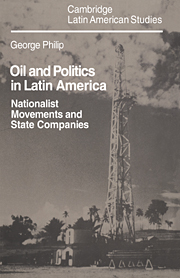Book contents
- Frontmatter
- Contents
- List of tables
- Preface
- Glossary
- Abbreviations
- Note on currencies and other units of measurement
- Maps: Latin America in 1920, 1940, 1960 and 1981; showing importing countries, exporting countries and countries self-sufficient in oil
- Introduction: The politics of oil in twentieth-century Latin America
- Part I The world oil environment
- 1 The corporate ascendancy 1890–1927
- 2 Retrenchment and concentration 1928–41
- 3 The making of the post-war oil world 1942–55
- 4 The major companies in retreat 1955–70
- 5 The oil market revolution and its consequences for Latin America 1971–9
- 6 Latin America in the twentieth-century oil system
- Part II The major expropriations
- Part III The state oil companies
- Notes and bibliography
- Index
- CAMBRIDGE LATIN AMERICAN STUDIES
1 - The corporate ascendancy 1890–1927
Published online by Cambridge University Press: 23 December 2009
- Frontmatter
- Contents
- List of tables
- Preface
- Glossary
- Abbreviations
- Note on currencies and other units of measurement
- Maps: Latin America in 1920, 1940, 1960 and 1981; showing importing countries, exporting countries and countries self-sufficient in oil
- Introduction: The politics of oil in twentieth-century Latin America
- Part I The world oil environment
- 1 The corporate ascendancy 1890–1927
- 2 Retrenchment and concentration 1928–41
- 3 The making of the post-war oil world 1942–55
- 4 The major companies in retreat 1955–70
- 5 The oil market revolution and its consequences for Latin America 1971–9
- 6 Latin America in the twentieth-century oil system
- Part II The major expropriations
- Part III The state oil companies
- Notes and bibliography
- Index
- CAMBRIDGE LATIN AMERICAN STUDIES
Summary
The starting point of the modern oil industry has traditionally been placed in 1859 with the drilling of the Drake well in Pennsylvania. During the rest of the nineteenth century, the USA in general and Standard Oil in particular established a dominant, even if not entirely unchallenged, position in the world oil market. In the mid-1860s the USA, by far the world's largest producer, exported well over half of its total production, having first refined most of it. In 1879 Standard Oil carried out its first foreign investment, in a marketing outlet in Spain.
The last three decades of the nineteenth century were also a period of rapid technical change. The oil industry, partly in consequence, became increasingly concentrated as Standard Oil built up its dominant position within the USA while facing increasingly intense political attack from its Populist and Progressive opponents. In the international market, Standard Oil was also a major force but nevertheless faced competition from Russian oil (which began to be produced around 1880) marketed by, among other companies, Shell and Royal Dutch (which merged in 1907).
Until the First World War, crude oil was abundant. Standard Oil built up its position by controlling transportation and refining within the USA and, to a lesser extent, marketing outlets outside it. Thus, at the turn of the century, the us oil industry was in an almost classic vent-for-surplus situation.
- Type
- Chapter
- Information
- Oil and Politics in Latin AmericaNationalist Movements and State Companies, pp. 7 - 42Publisher: Cambridge University PressPrint publication year: 1982



